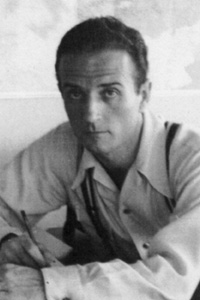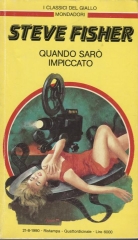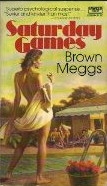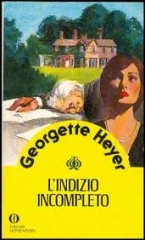The Blue Dahlia,
1946. Directed by George Marshall; Produced by John Houseman; Written by Raymond
Chandler. Cast: Alan Ladd, Veronica Lake, William Bendix, Howard Da Silva,
Doris Bowling. Paramount, USA, 94 min., b/w.
As you know,
Raymond Chandler, like many of his time, was busy as a writer, the celluloid
industry, however, the only specially prepared script for a film, that was for "The Blue Dahlia ", directed by
George Marshall.
George Marshall was a director rather eclectic film ranged from comic to film westerns, crime movies.
In our case, signs a delightful film, by that strip of film noir in 40s, that respects the canonicity of similar films (the unfaithful woman, the man betrayed the gangster, punch, smoke and alcohol in abundance, and a good offense, and of course the innocent who must prove his innocence against all), but enriches it with the motif strongly felt in those years, the veterans returned home as heroes, and then prevented by circumstances other than back into the everyday world. It almost seems the plot of Rambo: even there, in the first of 4 movies, the theme was the failure to return to work and to normal life of the veteran, rejected by the very people who ought to have a hero's welcome.
Here there are three veterans: Captain Navy aviation, Johnny Morrison, who is the protagonist of the story, his subordinate and his friend Buzz Wanchek, that due to a bullet in the skull suffers from hallucinations, severe headaches, moments of absence and severe amnesia, and their friend George Copeland. Johnny returns home, hoping that his wife Helen is waiting (but in a sense predicting the opposite), and locates her in the middle of a party in his apartment, in a bungalow hotel complex, with friends who he doesn’t know, and he betrays a certain Eddie Harwood, owner of a local, “The Blue Dahlia”.
But it’s not so much to discover that his wife has a lover but that she was the cause of death of their only son, the spring that triggers an argument between the couple, after which, Johnny leaves his wife for ever, that could have killed, together with his pistol, a 45.
George Marshall was a director rather eclectic film ranged from comic to film westerns, crime movies.
In our case, signs a delightful film, by that strip of film noir in 40s, that respects the canonicity of similar films (the unfaithful woman, the man betrayed the gangster, punch, smoke and alcohol in abundance, and a good offense, and of course the innocent who must prove his innocence against all), but enriches it with the motif strongly felt in those years, the veterans returned home as heroes, and then prevented by circumstances other than back into the everyday world. It almost seems the plot of Rambo: even there, in the first of 4 movies, the theme was the failure to return to work and to normal life of the veteran, rejected by the very people who ought to have a hero's welcome.
Here there are three veterans: Captain Navy aviation, Johnny Morrison, who is the protagonist of the story, his subordinate and his friend Buzz Wanchek, that due to a bullet in the skull suffers from hallucinations, severe headaches, moments of absence and severe amnesia, and their friend George Copeland. Johnny returns home, hoping that his wife Helen is waiting (but in a sense predicting the opposite), and locates her in the middle of a party in his apartment, in a bungalow hotel complex, with friends who he doesn’t know, and he betrays a certain Eddie Harwood, owner of a local, “The Blue Dahlia”.
But it’s not so much to discover that his wife has a lover but that she was the cause of death of their only son, the spring that triggers an argument between the couple, after which, Johnny leaves his wife for ever, that could have killed, together with his pistol, a 45.
It's
raining cats
and dogs: Johnny comes
out of a
second and disappears. Located randomly on the street - look at the coincidences - a beautiful blonde who gives him a ride (Joyce Harwood) to turn his wife Helen's lover. But while the two travel by car, someone really wants to kill the wife of Johnny, which is thus suspected to be the perfect murder. At this point he should try in every way to find the murderess of his wife and prove his innocence, the right help Joyce, fell in love with him, and broke with her husband.
At this point, Johnny collides with Eddie and his partner, a scoundrel with whom he has robbed a bank messenger boy killed for nothing: the two are wanted for many years, but they changed their names and now they are protected from any investigation, as long as Johnny does not understand, warned from the back of a photo, taken at the home of his wife, that Eddie is actually the false name behind which lies a murderess: it would seem at this point that the two were involved in 'murder of his wife, but it is not. And so the final will be a confession of the unexpected unexpected, as is the recognition that what seemed a confession (Buzz Wanchek fails to focus on what made the night of the murder, and is prey to terrible memories: Helen tore the petals of a flower one by one, a frightening noise and loud music) really is not.
At this point, Johnny collides with Eddie and his partner, a scoundrel with whom he has robbed a bank messenger boy killed for nothing: the two are wanted for many years, but they changed their names and now they are protected from any investigation, as long as Johnny does not understand, warned from the back of a photo, taken at the home of his wife, that Eddie is actually the false name behind which lies a murderess: it would seem at this point that the two were involved in 'murder of his wife, but it is not. And so the final will be a confession of the unexpected unexpected, as is the recognition that what seemed a confession (Buzz Wanchek fails to focus on what made the night of the murder, and is prey to terrible memories: Helen tore the petals of a flower one by one, a frightening noise and loud music) really is not.
Of course the film ends with the two main characters Johnny and Joyce greet
you but what you say makes you think that a little later will meet again.
The film, beautifully directed and acted, he entered the quintet of eligible candidates for an Oscar for best screenplay in 1946. As for the players, we must especially mention Johnny and Joyce, who was Alan Ladd and Veronica Lake, very close-knit pair at the time. At the time, Lake was on the crest of the wave, so that the hairstyle that she had launched (a fringe falling over one eye by hiding it) had infected a lot of the female audience. As that hair had caused many accidents, especially among workers, whose hair was drawn between the gears of the machinery, the government asked Lake to change her hairstyle.
Ladd hand, while being appreciated, especially because of the low-budget movies they always sell a lot, really became famous a few years later with the interpretation of “Shane” (1953).
The third actor in this poster along with Ladd and Lake, was William Bendix, characterizations of the time, whose role in the film would not seem to be on the same plane as the first two, so why was placed next to them? For the popularity? Bendix is true that some years before he was nominated for an Oscar for Best Performance by Actor in Wake Island (1942) by John Farrow, and had been with Ladd and Lake in “The Glass Key” (1942) from a work by Dashiell Hammett (screenplay by Jonathan Latimer), and then a magnificent interpreter of Alfred Hitchcock's Lifeboat (1944), a film in half and psychological warfare.
Here she seems to play a role all its own. Indeed, as the film proceeds, a not inconsiderable part focuses on the characterization of the veteran with shrapnel in the brain and prey to strong amnesia and hallucinations, for how he behaves and what he says, at some point it would almost seem to be in films the murderer. In reality, it was learned that Chandler had in fact intended that, the part of the murderer (he had to kill the faithless Helen, because very attached to her husband Johnny), until it was - by American military authorities - refused that a veteran and for more disabled, could be attributed to the characterization of a murderer. So Chandler changed the identity of the murderer. But as the film progresses, I repeat, it seemed to me that this shift had not occurred before the beginning of the film, but along the way: in fact, the drama tends to Buzz, which would be an ideal guilty, and with a strong psychological, until a sharp turn at the end, the less likely it is identified with a motivation of the killers and truly laughable: blackmail. The murderer would have blackmailed for her affair with Eddie, threatening to reveal everything to her husband, but she refused and so, fearing that she revealed all to Eddie, he would kill her; everything now when Helen was left forever by Johnny and she also broke up with Eddie, played by Howard Da Silva
The film, beautifully directed and acted, he entered the quintet of eligible candidates for an Oscar for best screenplay in 1946. As for the players, we must especially mention Johnny and Joyce, who was Alan Ladd and Veronica Lake, very close-knit pair at the time. At the time, Lake was on the crest of the wave, so that the hairstyle that she had launched (a fringe falling over one eye by hiding it) had infected a lot of the female audience. As that hair had caused many accidents, especially among workers, whose hair was drawn between the gears of the machinery, the government asked Lake to change her hairstyle.
Ladd hand, while being appreciated, especially because of the low-budget movies they always sell a lot, really became famous a few years later with the interpretation of “Shane” (1953).
The third actor in this poster along with Ladd and Lake, was William Bendix, characterizations of the time, whose role in the film would not seem to be on the same plane as the first two, so why was placed next to them? For the popularity? Bendix is true that some years before he was nominated for an Oscar for Best Performance by Actor in Wake Island (1942) by John Farrow, and had been with Ladd and Lake in “The Glass Key” (1942) from a work by Dashiell Hammett (screenplay by Jonathan Latimer), and then a magnificent interpreter of Alfred Hitchcock's Lifeboat (1944), a film in half and psychological warfare.
Here she seems to play a role all its own. Indeed, as the film proceeds, a not inconsiderable part focuses on the characterization of the veteran with shrapnel in the brain and prey to strong amnesia and hallucinations, for how he behaves and what he says, at some point it would almost seem to be in films the murderer. In reality, it was learned that Chandler had in fact intended that, the part of the murderer (he had to kill the faithless Helen, because very attached to her husband Johnny), until it was - by American military authorities - refused that a veteran and for more disabled, could be attributed to the characterization of a murderer. So Chandler changed the identity of the murderer. But as the film progresses, I repeat, it seemed to me that this shift had not occurred before the beginning of the film, but along the way: in fact, the drama tends to Buzz, which would be an ideal guilty, and with a strong psychological, until a sharp turn at the end, the less likely it is identified with a motivation of the killers and truly laughable: blackmail. The murderer would have blackmailed for her affair with Eddie, threatening to reveal everything to her husband, but she refused and so, fearing that she revealed all to Eddie, he would kill her; everything now when Helen was left forever by Johnny and she also broke up with Eddie, played by Howard Da Silva
And Raymond Chandler?
Judith Freeman, "The Long Embrace", Random House (2008), says that Chandler had interrupted the wonderful script and he didn’t know how to continue it and finish it. In fact, become a teetotaler for a cure from too much alcohol that he sent down, he could not break in more, as it were alcohol gasoline engine of his brain. The fact is that he agreed to finish the script in exchange for a crate of bottles of Scotch whiskey, and drank every day, until a few weeks later he managed to finish it and hand it over.
A final curiosity: Raymond Chandler's hostility to on many occasions Classic Mystery, the Twenties and Thirties (Christie, Sayers and especially among the American Van Dine and his followers) and the understanding of the police investigation, preferring realism the imagination, suburban environments to those of the rich bourgeoisie and the aristocracy banking business.
However, in a passage of the film, we see how this intellectual detective story, although in words challenged his colleagues brain more sensitive to the survey, it probably subliminally he copyied the styles. In fact, the photo of his wife that he takes away from the clamp system where there is also that of her dead son, back behind the words: “Johnny, of anything happens to me, Harwood Eddie Bauer's name used to be. The New Jersey State Police would like to know. The charge is murder. Helen.” .His wife wrote it because he feared being killed by Eddie. Then she died.
Judith Freeman, "The Long Embrace", Random House (2008), says that Chandler had interrupted the wonderful script and he didn’t know how to continue it and finish it. In fact, become a teetotaler for a cure from too much alcohol that he sent down, he could not break in more, as it were alcohol gasoline engine of his brain. The fact is that he agreed to finish the script in exchange for a crate of bottles of Scotch whiskey, and drank every day, until a few weeks later he managed to finish it and hand it over.
A final curiosity: Raymond Chandler's hostility to on many occasions Classic Mystery, the Twenties and Thirties (Christie, Sayers and especially among the American Van Dine and his followers) and the understanding of the police investigation, preferring realism the imagination, suburban environments to those of the rich bourgeoisie and the aristocracy banking business.
However, in a passage of the film, we see how this intellectual detective story, although in words challenged his colleagues brain more sensitive to the survey, it probably subliminally he copyied the styles. In fact, the photo of his wife that he takes away from the clamp system where there is also that of her dead son, back behind the words: “Johnny, of anything happens to me, Harwood Eddie Bauer's name used to be. The New Jersey State Police would like to know. The charge is murder. Helen.” .His wife wrote it because he feared being killed by Eddie. Then she died.
This message is or is not
a “dying message”, trademark of Ellery Queen?
Pietro De Palma








